India’s development vis-à-vis Bangladesh, China, Pakistan
(Created page with "{| Class="wikitable" |- |colspan="0"|<div style="font-size:100%"> This is a collection of articles archived for the excellence of their content.<br/> </div> |} [[Category:Ind...") |
(→The Rupee, Indian vis-à-vis Pakistani) |
||
| (5 intermediate revisions by one user not shown) | |||
| Line 6: | Line 6: | ||
|} | |} | ||
| − | + | ||
| − | + | ||
| − | + | ||
| − | + | ||
| − | + | ||
| − | + | ||
| | ||
| − | = | + | =Over the years= |
| + | ==1960> 2015: Bangladesh, China, India, Pakistan== | ||
[http://epaperbeta.timesofindia.com/Article.aspx?eid=31808&articlexml=India-is-an-economic-GIANT-but-a-social-02022017011001 India is an economic GIANT but a social PYGMY compared to Bangladesh, Feb 02 2017: The Times of India] | [http://epaperbeta.timesofindia.com/Article.aspx?eid=31808&articlexml=India-is-an-economic-GIANT-but-a-social-02022017011001 India is an economic GIANT but a social PYGMY compared to Bangladesh, Feb 02 2017: The Times of India] | ||
[[File: Per capita income, India, China, Pakistan and Bangladesh, 1960-2015.jpg|Per capita income, India, China, Pakistan and Bangladesh, 1960-2015; [http://epaperbeta.timesofindia.com/Article.aspx?eid=31808&articlexml=India-is-an-economic-GIANT-but-a-social-02022017011001 India is an economic GIANT but a social PYGMY compared to Bangladesh, Feb 02 2017: The Times of India]|frame|500px]] | [[File: Per capita income, India, China, Pakistan and Bangladesh, 1960-2015.jpg|Per capita income, India, China, Pakistan and Bangladesh, 1960-2015; [http://epaperbeta.timesofindia.com/Article.aspx?eid=31808&articlexml=India-is-an-economic-GIANT-but-a-social-02022017011001 India is an economic GIANT but a social PYGMY compared to Bangladesh, Feb 02 2017: The Times of India]|frame|500px]] | ||
| + | [[File: Growth, Bangladesh, China, India and Pakistan.jpg|Growth, Bangladesh, China, India and Pakistan; [http://epaperbeta.timesofindia.com/Article.aspx?eid=31808&articlexml=India-is-an-economic-GIANT-but-a-social-02022017011001 India is an economic GIANT but a social PYGMY compared to Bangladesh, Feb 02 2017: The Times of India]|frame|500px]] | ||
| + | |||
| + | [[File: Illiterate population, Bangladesh, China, India and Pakistan.jpg|Illiterate population, Bangladesh, China, India and Pakistan; [http://epaperbeta.timesofindia.com/Article.aspx?eid=31808&articlexml=India-is-an-economic-GIANT-but-a-social-02022017011001 India is an economic GIANT but a social PYGMY compared to Bangladesh, Feb 02 2017: The Times of India]|frame|500px]] | ||
| + | |||
| + | [[File: Number of poor and fertility rate, a comparison, Bangladesh, China, India and Pakistan.jpg|Number of poor and fertility rate, Bangladesh, China, India and Pakistan; [http://epaperbeta.timesofindia.com/Article.aspx?eid=31808&articlexml=India-is-an-economic-GIANT-but-a-social-02022017011001 India is an economic GIANT but a social PYGMY compared to Bangladesh, Feb 02 2017: The Times of India]|frame|500px]] | ||
| + | |||
| + | [[File: Infant mortality rate, Bangladesh, China, India and Pakistan.jpg|Infant mortality rate, Bangladesh, China, India and Pakistan; [http://epaperbeta.timesofindia.com/Article.aspx?eid=31808&articlexml=India-is-an-economic-GIANT-but-a-social-02022017011001 India is an economic GIANT but a social PYGMY compared to Bangladesh, Feb 02 2017: The Times of India]|frame|500px]] | ||
| + | |||
| + | [[File: Life expectancy at birth, Bangladesh, China, India and Pakistan.jpg|Life expectancy at birth, Bangladesh, China, India and Pakistan; [http://epaperbeta.timesofindia.com/Article.aspx?eid=31808&articlexml=India-is-an-economic-GIANT-but-a-social-02022017011001 India is an economic GIANT but a social PYGMY compared to Bangladesh, Feb 02 2017: The Times of India]|frame|500px]] | ||
India, China, Pakistan, Sri Lanka and Bangladesh gained independence around the same time. Until 1960 all four countries had almost identical per capita income. Today China is an economic miracle with impressive human development indicators (HDI). Bangladesh is an economic pygmy but outshines even China on improvements in a few social parameters. India's record is mixed.Sri Lanka, meantime, is not only ahead of its South Asian neighbours by miles -it ranks 73 compared to India's 130 on the HD Index -it's better placed than even China (which is at 90). Pakistan, at 147, is the laggard in this pack | India, China, Pakistan, Sri Lanka and Bangladesh gained independence around the same time. Until 1960 all four countries had almost identical per capita income. Today China is an economic miracle with impressive human development indicators (HDI). Bangladesh is an economic pygmy but outshines even China on improvements in a few social parameters. India's record is mixed.Sri Lanka, meantime, is not only ahead of its South Asian neighbours by miles -it ranks 73 compared to India's 130 on the HD Index -it's better placed than even China (which is at 90). Pakistan, at 147, is the laggard in this pack | ||
| + | |||
| + | |||
| + | ==1965> 2016, 17: India vs. Pakistan== | ||
| + | [https://epaper.timesgroup.com/Olive/ODN/TimesOfIndia/shared/ShowArticle.aspx?doc=TOIDEL%2F2018%2F08%2F16&entity=Ar01400&sk=6E11C79D&mode=text Rohit Saran, Five Wars That Pakistan Lost, August 16, 2018: ''The Times of India''] | ||
| + | |||
| + | [[File: India vis-à-vis Pakistan in 1965 and 2016, 17- per capita income, life expectancy, fertility rate, exports and mortality rate.jpg|India vis-à-vis Pakistan in 1965 and 2016, 17- per capita income, life expectancy, fertility rate, exports and mortality rate <br/> From: [https://epaper.timesgroup.com/Olive/ODN/TimesOfIndia/shared/ShowArticle.aspx?doc=TOIDEL%2F2018%2F08%2F16&entity=Ar01400&sk=6E11C79D&mode=text Rohit Saran, Five Wars That Pakistan Lost, August 16, 2018: ''The Times of India'']|frame|500px]] | ||
| + | |||
| + | ''And why India shouldn’t let it lose another one'' | ||
| + | |||
| + | It may have looked moth-eaten to its founder Mohammad Ali Jinnah, but Pakistan was anything but that at the time of Independence. An average Pakistani was richer, lived longer and lived more safely than an average Indian for almost two decades after 1947, which is roughly the time democracy was absent in Pakistan. | ||
| + | |||
| + | Ironically, Pakistan’s socioeconomic slide started around the time Imran Khan’s performance on the cricket field was peaking. As he led his team to victories in the 1980s, his country began to slip behind India – first slowly and then quickly and irrevocably. Of course, that was a coincidence. Less coincidentally, Kashmir unrest too had begun to boil over by the late 1980s and Pakistan’s support for the ‘cause’ had gone from being covert to overt. | ||
| + | |||
| + | The consequence? An average Pakistani today earns 15% less than an Indian whereas in 1985 Indians were 15% poorer. With its GDP growth rate lower and population growth higher than India’s, the prosperity gap will widen further. On average, a Pakistan citizen consumes 24% less energy (used to be 10% higher), lives a shorter life and is less educated than an Indian. Even Bangladesh, which was a poorer part of Pakistan for 24 years, has marched ahead on all markers of social progress. | ||
| + | |||
| + | One factor on which Pakistan has always been way ahead of India is defence spending, and that’s one big reason why it’s losing the five wars shown in the graphs. As Pakistani-American historian Ayesha Jalal told Scroll recently, the reasons were rooted in the way the country was born – it inherited one-third of undivided India’s military, but only 18% of the area that contributed to tax revenue. | ||
| + | |||
| + | Pakistan’s army, which ruled the country 52% of the time directly and 100% of the time indirectly, had no incentive to correct this congenital defect. We aren’t even getting into the fate of the four Indo-Pak military conflicts because victory and loss in those wars arguably matters less than losing the war to build a better country. | ||
| + | |||
| + | As Pakistan started sliding, its urge to be counted as an equal became stronger. The most futile expression of that was the nuclear test of 1998, within days of India’s test. There is nothing wrong in aiming for equality, or even superiority. But equality in what and at what price? Trading years of superiority in income, healthcare and infrastructure with equality on nuclear warheads is a crime on the people of Pakistan. Ending such crimes on his people should be Prime Minister Imran Khan’s priority. | ||
| + | |||
| + | What can India offer to Prime Minister Khan that’s new, substantive and outside the immediate no-go areas of J&K and terror? We should first banish the thought that a weak Pakistan is good for us. A crippled Pakistan is only good for two things: 1. Shouting matches on TV where those criticising India are asked to migrate to Pakistan. 2. To give us a false sense of achievement in doing better than Pakistan when India’s potential-performance gap is much wider than Pakistan’s. | ||
| + | |||
| + | A less hostile public attitude toward our neighbour will allow government to take a few out-of-the box steps. For instance, Indian companies should be allowed and encouraged to hire from top Pakistan campuses, even if for one or two years. If only 30 Sensex companies hire 50 Pakistanis each, there will be 1,500 young and talented Pakistanis working and living in India benefiting, and benefiting from, the world’s 6th – and soon to be 5th – largest economy. Companies will get good talent at competitive salaries – Pakistani rupee is nearly half the value of Indian rupee. For those worrying about a job loss for Indians, 1,500 is only 0.0007% of Sensex companies’ workforce. | ||
| + | |||
| + | Imran Khan’s passport has more Indian visas than any prime minister of Pakistan. Unfortunately, India allows only the rich and powerful in Pakistan to benefit from India’s soft power. That’s counterproductive to our own interests. We should want average Pakistanis to see India as a source of good to them. They will then begin to resent whatever power comes between that ‘good’ and them – whether that power is in Rawalpindi or Islamabad or Beijing – or even Srinagar. | ||
| + | |||
| + | Aspiring cricketers in Pakistan will dream of playing in IPL if we unblocked their entry. A budding artist (actors, singers, comedians …) in that country will look forward to hitting the big stage in India, if we don’t hum and haw over granting him a visa. Pakistanis with a critical medical condition in the family should want to get treatment in India – without having to try their luck on Sushma Swaraj’s Twitter handle. Pakistan should be allowed to fill its quota of students at the South Asian University, something we committed to at the time of deciding to host this institution that could one day be the region’s most coveted. | ||
| + | |||
| + | Not one of these will be acts of charity or concession because India’s gains will be as much as Pakistan’s – if not more. This is exactly what we tell the US while arguing for easier immigration. In geopolitics there is no positive emotion as powerful as seeing your countrymen excel in another country. India has that power in its grasp today. Let’s use Imran’s prime ministership as an occasion to unleash that power. | ||
| + | |||
| + | Indian companies should be allowed to hire from top Pakistan campuses. If only 30 Sensex companies hire 50 Pakistanis each there will be 1,500 talented Pakistanis working in India. | ||
| + | |||
| + | =The Rupee, Indian vis-à-vis Pakistani= | ||
| + | ==2017-19== | ||
| + | [[File: The value of the Rupee, Indian and Pakistani, 2017-19.jpg|The value of the Rupee, Indian and Pakistani, 2017-19 <br/> From: [https://epaper.timesgroup.com/olive/apa/timesofindia/SharedView.Article.aspx?href=TOIM%2F2019%2F05%2F18&id=Ar02307&sk=B5DDFDF2&viewMode=image May 18, 2019: ''The Times of India'']|frame|500px]] | ||
| + | |||
| + | See graphic, ' The value of the Rupee, Indian and Pakistani, 2017-19' | ||
| + | |||
| + | [[Category:Bangladesh|D INDIA’S DEVELOPMENT VIS-À-VIS BANGLADESH, CHINA, PAKISTANINDIA’S DEVELOPMENT VIS-À-VIS BANGLADESH, CHINA, PAKISTAN | ||
| + | INDIA’S DEVELOPMENT VIS-À-VIS BANGLADESH, CHINA, PAKISTAN]] | ||
| + | [[Category:China|D INDIA’S DEVELOPMENT VIS-À-VIS BANGLADESH, CHINA, PAKISTANINDIA’S DEVELOPMENT VIS-À-VIS BANGLADESH, CHINA, PAKISTAN | ||
| + | INDIA’S DEVELOPMENT VIS-À-VIS BANGLADESH, CHINA, PAKISTAN]] | ||
| + | [[Category:Development|D INDIA’S DEVELOPMENT VIS-À-VIS BANGLADESH, CHINA, PAKISTANINDIA’S DEVELOPMENT VIS-À-VIS BANGLADESH, CHINA, PAKISTAN | ||
| + | INDIA’S DEVELOPMENT VIS-À-VIS BANGLADESH, CHINA, PAKISTAN]] | ||
| + | [[Category:Economy-Industry-Resources|D INDIA’S DEVELOPMENT VIS-À-VIS BANGLADESH, CHINA, PAKISTANINDIA’S DEVELOPMENT VIS-À-VIS BANGLADESH, CHINA, PAKISTAN | ||
| + | INDIA’S DEVELOPMENT VIS-À-VIS BANGLADESH, CHINA, PAKISTAN]] | ||
| + | [[Category:India|D INDIA’S DEVELOPMENT VIS-À-VIS BANGLADESH, CHINA, PAKISTANINDIA’S DEVELOPMENT VIS-À-VIS BANGLADESH, CHINA, PAKISTAN | ||
| + | INDIA’S DEVELOPMENT VIS-À-VIS BANGLADESH, CHINA, PAKISTAN]] | ||
| + | [[Category:Pakistan|D INDIA’S DEVELOPMENT VIS-À-VIS BANGLADESH, CHINA, PAKISTANINDIA’S DEVELOPMENT VIS-À-VIS BANGLADESH, CHINA, PAKISTAN | ||
| + | INDIA’S DEVELOPMENT VIS-À-VIS BANGLADESH, CHINA, PAKISTAN]] | ||
Latest revision as of 16:36, 21 November 2020
This is a collection of articles archived for the excellence of their content. |
Contents |
[edit] Over the years
[edit] 1960> 2015: Bangladesh, China, India, Pakistan
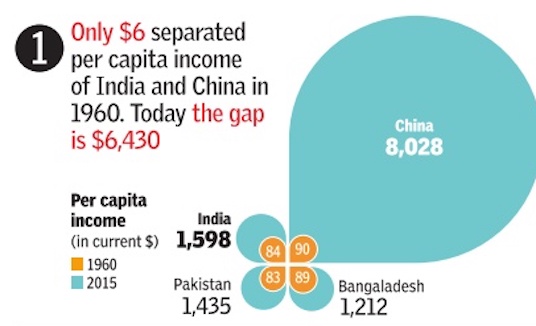
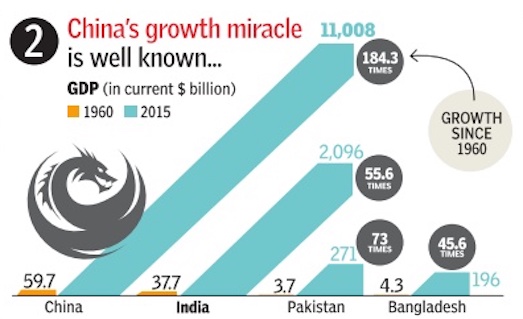
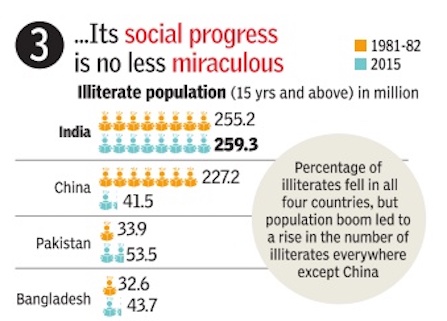

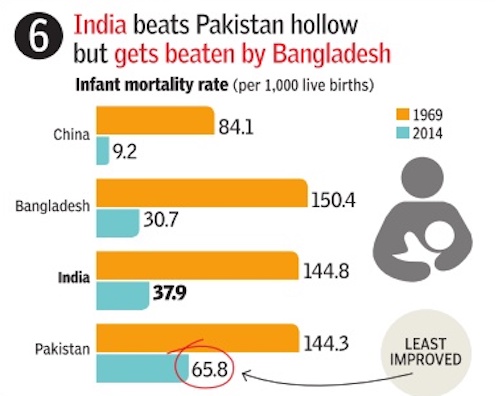

India, China, Pakistan, Sri Lanka and Bangladesh gained independence around the same time. Until 1960 all four countries had almost identical per capita income. Today China is an economic miracle with impressive human development indicators (HDI). Bangladesh is an economic pygmy but outshines even China on improvements in a few social parameters. India's record is mixed.Sri Lanka, meantime, is not only ahead of its South Asian neighbours by miles -it ranks 73 compared to India's 130 on the HD Index -it's better placed than even China (which is at 90). Pakistan, at 147, is the laggard in this pack
[edit] 1965> 2016, 17: India vs. Pakistan
Rohit Saran, Five Wars That Pakistan Lost, August 16, 2018: The Times of India
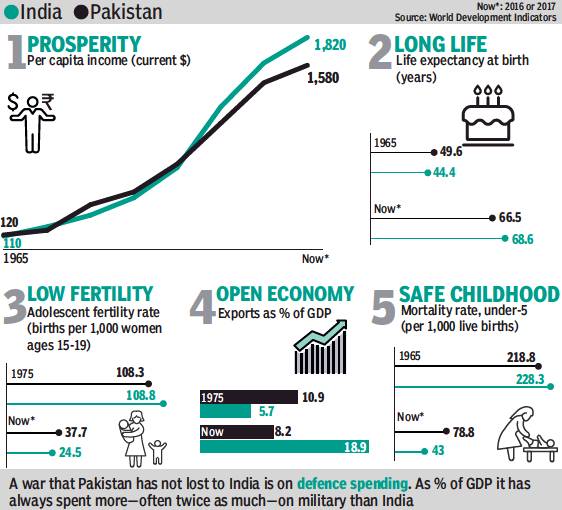
From: Rohit Saran, Five Wars That Pakistan Lost, August 16, 2018: The Times of India
And why India shouldn’t let it lose another one
It may have looked moth-eaten to its founder Mohammad Ali Jinnah, but Pakistan was anything but that at the time of Independence. An average Pakistani was richer, lived longer and lived more safely than an average Indian for almost two decades after 1947, which is roughly the time democracy was absent in Pakistan.
Ironically, Pakistan’s socioeconomic slide started around the time Imran Khan’s performance on the cricket field was peaking. As he led his team to victories in the 1980s, his country began to slip behind India – first slowly and then quickly and irrevocably. Of course, that was a coincidence. Less coincidentally, Kashmir unrest too had begun to boil over by the late 1980s and Pakistan’s support for the ‘cause’ had gone from being covert to overt.
The consequence? An average Pakistani today earns 15% less than an Indian whereas in 1985 Indians were 15% poorer. With its GDP growth rate lower and population growth higher than India’s, the prosperity gap will widen further. On average, a Pakistan citizen consumes 24% less energy (used to be 10% higher), lives a shorter life and is less educated than an Indian. Even Bangladesh, which was a poorer part of Pakistan for 24 years, has marched ahead on all markers of social progress.
One factor on which Pakistan has always been way ahead of India is defence spending, and that’s one big reason why it’s losing the five wars shown in the graphs. As Pakistani-American historian Ayesha Jalal told Scroll recently, the reasons were rooted in the way the country was born – it inherited one-third of undivided India’s military, but only 18% of the area that contributed to tax revenue.
Pakistan’s army, which ruled the country 52% of the time directly and 100% of the time indirectly, had no incentive to correct this congenital defect. We aren’t even getting into the fate of the four Indo-Pak military conflicts because victory and loss in those wars arguably matters less than losing the war to build a better country.
As Pakistan started sliding, its urge to be counted as an equal became stronger. The most futile expression of that was the nuclear test of 1998, within days of India’s test. There is nothing wrong in aiming for equality, or even superiority. But equality in what and at what price? Trading years of superiority in income, healthcare and infrastructure with equality on nuclear warheads is a crime on the people of Pakistan. Ending such crimes on his people should be Prime Minister Imran Khan’s priority.
What can India offer to Prime Minister Khan that’s new, substantive and outside the immediate no-go areas of J&K and terror? We should first banish the thought that a weak Pakistan is good for us. A crippled Pakistan is only good for two things: 1. Shouting matches on TV where those criticising India are asked to migrate to Pakistan. 2. To give us a false sense of achievement in doing better than Pakistan when India’s potential-performance gap is much wider than Pakistan’s.
A less hostile public attitude toward our neighbour will allow government to take a few out-of-the box steps. For instance, Indian companies should be allowed and encouraged to hire from top Pakistan campuses, even if for one or two years. If only 30 Sensex companies hire 50 Pakistanis each, there will be 1,500 young and talented Pakistanis working and living in India benefiting, and benefiting from, the world’s 6th – and soon to be 5th – largest economy. Companies will get good talent at competitive salaries – Pakistani rupee is nearly half the value of Indian rupee. For those worrying about a job loss for Indians, 1,500 is only 0.0007% of Sensex companies’ workforce.
Imran Khan’s passport has more Indian visas than any prime minister of Pakistan. Unfortunately, India allows only the rich and powerful in Pakistan to benefit from India’s soft power. That’s counterproductive to our own interests. We should want average Pakistanis to see India as a source of good to them. They will then begin to resent whatever power comes between that ‘good’ and them – whether that power is in Rawalpindi or Islamabad or Beijing – or even Srinagar.
Aspiring cricketers in Pakistan will dream of playing in IPL if we unblocked their entry. A budding artist (actors, singers, comedians …) in that country will look forward to hitting the big stage in India, if we don’t hum and haw over granting him a visa. Pakistanis with a critical medical condition in the family should want to get treatment in India – without having to try their luck on Sushma Swaraj’s Twitter handle. Pakistan should be allowed to fill its quota of students at the South Asian University, something we committed to at the time of deciding to host this institution that could one day be the region’s most coveted.
Not one of these will be acts of charity or concession because India’s gains will be as much as Pakistan’s – if not more. This is exactly what we tell the US while arguing for easier immigration. In geopolitics there is no positive emotion as powerful as seeing your countrymen excel in another country. India has that power in its grasp today. Let’s use Imran’s prime ministership as an occasion to unleash that power.
Indian companies should be allowed to hire from top Pakistan campuses. If only 30 Sensex companies hire 50 Pakistanis each there will be 1,500 talented Pakistanis working in India.
[edit] The Rupee, Indian vis-à-vis Pakistani
[edit] 2017-19
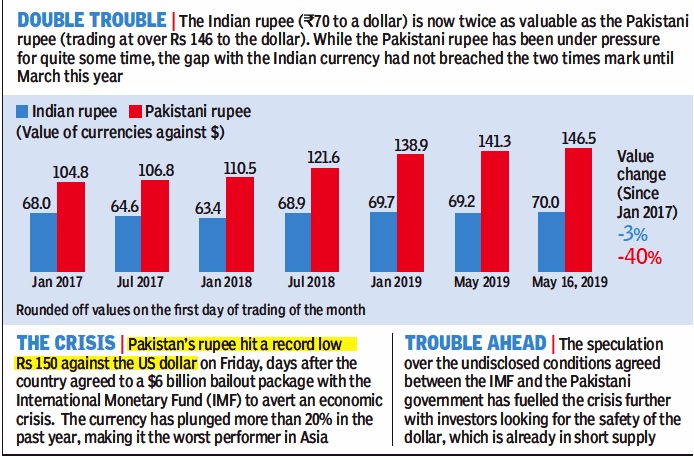
From: May 18, 2019: The Times of India
See graphic, ' The value of the Rupee, Indian and Pakistani, 2017-19'